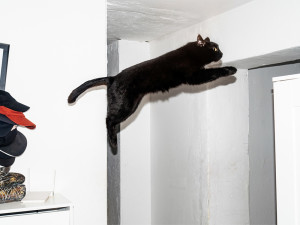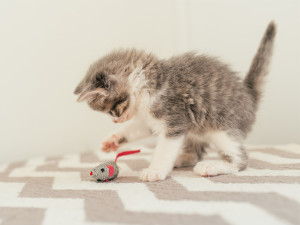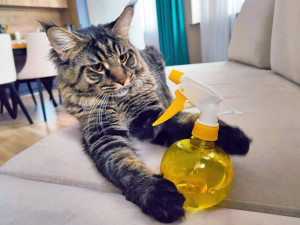How Do You Train a Cat to Stay Off Counters?
Excuse me, kitty; that is not your personal balance beam.

Share Article
In This Article:
Why Do Cats Jump on Counters? How To Train Your Cat To Stay Off Counters Common Mistakes During Cat Training What If Nothing Is Working? Frequently Asked Questions
Training cats to stay off counters requires determination, positive reinforcement, and understanding your cat’s natural instincts. You can successfully redirect their behavior and maintain a hygienic kitchen by making counters less appealing while providing attractive alternatives. You can also use training techniques to encourage your kitty to make better choices about where to go… keeping your kitchen counters free of paws that have been you-know-where (cough, the litter box).
Why do cats jump on counters?
Understanding why cats want to counter-surf is key to stopping the behavior. Let’s take a look at some of the most common reasons why cats find counters so attractive:
Natural instincts
In nature, cats climb trees and rocks, venturing throughout their three-dimensional environment. As both predators and prey, cats are naturally drawn to high places. From higher vantage points, they can keep themselves safe from other predators, and remain hidden from potential prey items they could be interested in hunting. With cats, positioning can be all about survival: what will help them avoid being eaten, and what can help them get food.

Interesting smells and food
Speaking of food, kitchen counters are not only a place where food can be found, but it’s also a place where food is often prepared. It has long been known that cats have an amazing sense of smellopens in new tab, and a hungryopens in new tab (or curious) kitty will prowl around places where food has been or is currently placed. And if your cat happens to find and eat some food when they’re up on the counter, that cat has been positively reinforced (with food) to revisit that location for more food at a later time.
Fresh running water
No, cats do not hate water — in fact, cats will often play in wateropens in new tab running from a tap. While it’s unclear as to whether this is drinking behavior or simply play, if your cat does not have adequate water resources in their home, your cat may be drawn to the kitchen faucet. Many cats prefer drinking water from bowls, but water fountains and glasses are also used by cats seeking to quench their thirst, and a running faucet (or bowls left in the sink) may just be another viable water source to a thirsty cat.
Curiosity
It’s no surprise that cats are curious animals — they’re prone to FOMO, and anything off-limits is at the top of the list for exploration. Countertops are fun to explore — they’re up high, sometimes yield prizes (food), and from there, cats can see what you’re up to when you’re preparing meals. Cats want to know what you’re doing, and it’s really difficult to make an assessment from the floor! Why not just hop up on the counter and see what’s really going on? Perhaps there’s a nice window next to the sink that allows for a great view of the birds in the neighbor’s yard, or there’s a beam of sunlight that makes the countertop cozy and warm… your cat will never know unless they jump up to find out.
How to train your cat to stay off counters
Now that we know why cats get up on counters, we can zero in on why your cat wants to be up on the counters. Are they hungry and need to be fed more? Do they need to have access to a different sunny window with a nice window bed or perch available for lounging? Are they bored and need more stimulation to keep little paws from getting in trouble? Whatever the case is, let’s focus on training your cat out of the habit of counter-surfing with a few tricks of the trade.
Keep your counters clear
If your cat is hungry or simply food-motivated and likes snacks, it’s best to keep all food off your counters. If your cat visits the counters when you’re not there and doesn’t find anything worthwhile, they’re less likely to revisit than if they find something to feast on.
Creating attractive cat-friendly zones
Because cats like being up high, ensure that you have plenty of vertical space options for your cat to utilize throughout your home. Perhaps the counter is the highest place your cat can get in the house; can you change that? Cat trees and shelving for cats are good places to start so that your kitty has tall vantage points to view rooms where their people often are or windows that show birds and squirrels scampering about outside.
Positive reinforcement
Here’s where we start talking about training. When your cat displays a behavior that you want them to repeat (i.e., a good behavior), reinforce it with some sort of reward — anything that your cat likes. This can be treats, praise, petting, or tossing a toy — there are many options for positive reinforcement. We’ll be talking more about this in a sec.
Provide alternative jump spaces
Place an “alternative perch” somewhere in the kitchen that your cat can use and get positively reinforced for doing so. Many people will use a tall bar stool or a cat tree and place it next to the counter — when the cat gets on that perch (and stays on it), the cat then gets rewarded. If the cat leaves the perch, the rewards stop. So, what’s the best place to be — counter without rewards, or perch with rewards? Hmm...
Clicker training
A click sound (made with a tongue-click or a clicker) can be utilized to mark when your cat jumps up on the alternative perch so that your cat knows that a reward is on its way. That click will buy you time between the good behavior and reward delivery, and the cat will learn that hearing a click is a good thing! There are many applications for clicker-training, and teaching your cat to use a perch is one of them.
Deterrents
Avoid using deterrents that will scare or startle your cat; these can cause stress and result in other behavior issues. Deterrents that make countertops less comfortable may be okay though; one of my go-to deterrents is double-sided sticky tape that you can put on cardboard or placemats, then put the cardboard or placemats wherever they are needed on the counters. Cats don’t like walking on sticky surfaces, and it won’t take long for them to avoid visiting those places.
Common mistakes during cat training
Training a cat really isn’t that difficult, you just need to find out what they’re willing to work for, and that can vary among cats. But one thing’s for sure, there are ways that your training can backfire. Here’s how to avoid common pitfalls:
Reinforcing the wrong thing
Reward only the behaviors that you want! For example, reward your cat for using their alternative perch — getting up onto it, and getting down from it. But don’t reward your cat for getting down from the counter… because what did they do to get that reward? Yup, they got up on the counter first. You can tell your cat to get off the counter, but no rewards for when they do.
Inconsistent rule enforcement
Try not to send mixed messages about your cat’s being on the counter. For instance, some people feed their cats on their counter, but then expect the cats to stay off the counters at all other times. Or, sometimes you tell your cat to get off the counter (or pick them up and place them on the floor), and other times you don’t. Consistency is key!
Not addressing underlying needs
Is your cat hungry and looking for food because they need more to eat? Doing a calorie assessment may be helpful to make sure you’re feeding your cat enough. Additionally, making sure your cat has several options for water, play, and other perching locations is also important. If those things aren’t addressed, your cat may continue to counter-surf in an effort to get their needs met.
Harsh punishment
Please don’t punish your cat. Avoid using the spray bottle and other punishments — these will cause stress and give your cat a reason to fear you. Additionally, they may just learn to do the behavior while you’re not around, and that’s a more difficult problem to solve.
What if nothing is working?
If nothing is working to keep your cat off the counters, there may be an underlying medical issue that is exacerbating hunger or stress. A visit to your vet or a talk with your friendly neighborhood cat behavior consultant may be in order.
FAQs:
How to clicker train a cat to stay off counters?
You can use clicker training to train your cat to stay off counters by setting up an alternative perch, then clicking when they use it, and immediately following the click with some sort of reward. Clicker training is an effective and fun way to train your cat to express an endless number of good behaviors.
Should you use a spray bottle to train a cat?
Using a spray bottle to train or discipline a cat is not encouraged, as it can result in stress-related behaviors such as aggression or house-soiling, your cat learning to do an unwanted behavior when you’re not present, or simply broken trust between you and your cat.
References:
Delgado, Mikel, and Leticia M.S. Dantas. “Feeding Cats for Optimal Mental and Behavioral Well-Being.” Veterinary Clinics of North America: Small Animal Practice, vol. 50, no. 5, Sept. 2020, pp. 939–953, www.ncbi.nlm.nih.gov/pmc/articles/PMC7415653/, https://doi.org/10.1016/j.cvsm.2020.05.003.
EDRIDGE-GREEN, F. W. “The Sense of Smell of Cats.” Nature, vol. 130, no. 3283, Oct. 1932, pp. 510–510, https://doi.org/10.1038/130510b0. Accessed 9 Mar. 2021.
Handl, Stefanie, and Julia Fritz. “The Water Requirements and Drinking Habits of Cats - Vet ...” Vetfocus.royalcanin.com, 12 Dec. 2018, vetfocus.royalcanin.com/en/scientific/the-water-requirements-and-drinking-habits-of-cats.

Marci Koski
Marci Koski fell in love with cats as a toddler and never looked back, even leaving a career as an endangered species biologist for the U.S. Fish and Wildlife Service to start her own cat behavior consulting service, Feline Behavior Solutions in 2014. Since then, Marci has been helping people resolve their cat behavior issues by teaching people “how to cat” — namely, how to give their cat the resources and environments they need to thrive with their human companions.
Marci has a PhD in Fishery and Wildlife Biology, and earned her specialized and advanced Feline Training and Behavior certifications through the Animal Behavior Institute.
Related articles
![Cat grabbing onto ledge of table and looking to the left]()
Why Does My Cat Follow Me Everywhere?
Yes, they are right behind you.
![A Burma breed cat on a leashed harness sitting near a feet of a girl at a pedestrian crossing.]()
How to Walk Your Cat on a Leash
Adventure Cats author Laura Moss’s step-by-step guide for hitting the streets with your cat.
![Maine coon cat gnaws spray bottle with water laying on sofa.]()
Why It’s Time to Stop Using a Spray Bottle to “Train” Your Cat
And how to really get them to stop jumping on the counter.
![Woman playing at home with her kitten.]()
How to Train Your Cat: Tips and Cues for Kittens
Seriously, it’s not as hard as you think.
How to Stop Your Cat From Munching On All of Your Precious Plants
Tips to get your cat to quit eating your greens.








